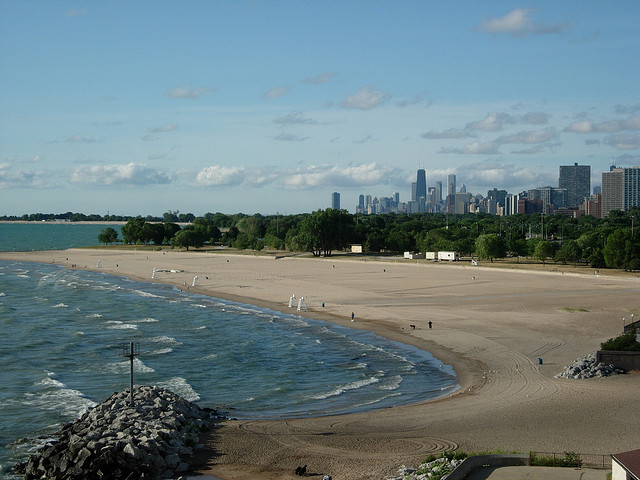It may sound more like a video game than a safety tool, but Virtual Beach doesn’t have any animated sand castles or surfers.
Instead, it contains forms to fill out with information on environmental factors that predict bacteria levels and tells beach managers when to close the beach.

Beach managers can predict bacteria levels using Virtual Beach. Photo: Scott Swanson
Beaches with high levels of bacteria could make swimmers and beachgoers sick. Most beach managers track bacteria levels by taking samples of water and sand to a laboratory. But contaminated beaches could stay open a whole day or longer before the results are returned.
With predictive computer models like Virtual Beach, managers can forecast beach cleanliness based on environmental conditions and make decisions quickly without waiting on lab results.
“We could avoid a lot of unnecessary advisories and days when beachgoers are potentially exposed to unhealthy conditions by making these predictions,” said Adam Mednick, research scientist with the Wisconsin Department of Natural Resources.
Virtual Beach version 2.2 was released in March, 2012. It has a mapping interface so users can see how wind direction affects their beaches, doesn’t require as much information to predict bacteria levels and gives users more power to manipulate data than the original version did.
“It’s more efficient now,” said Mike Cyterski, research ecologist for the EPA.
Cyterski guessed there are 50 to 100 Great Lakes beaches using Virtual Beach to predict unsafe bacteria levels.
Only two Wisconsin beaches used Virtual Beach in 2011, but Mednick hopes to have 20 using it by 2013.
Beach managers can still test water samples for bacteria and input that data into Virtual Beach, making future predictions even more accurate.
“You link together information that very often is already available, like meteorological data or weather conditions, maybe how many birds are on the beach,” said Richard Zepp, research scientist with the EPA.
“In some cases you can make predictions that are about 80-90 percent accurate as to whether you’ll be above the EPA criteria or below it,” he said.
Predictive models vary by beach. Rainfall may matter more for beaches that get a lot of runoff, and water clarity may matter more for beaches where water doesn’t circulate well throughout the lake.
And Virtual Beach can predict more than just bacteria levels. Zepp said with the right information it can predict levels of nitrogen and phosphorus, nutrients that promote algae growth.
Dan Ziegler, environmental health specialist for the Ozaukee County Health Department in Wisconsin, has been using Virtual Beach since 2009 on the county’s four Lake Michigan beaches.
Using the program doesn’t take long because environmental health employees in Ozaukee County collect data about the beach environment for an EPA beach sanitary survey, he said.
Other data needed to run Virtual Beach can be found at the National Weather service’s website.
Ziegler has used Virtual Beach predictions to post advisories and close beaches. But after so much time watching the software make predictions, he can almost make them himself.
“I’ve been doing this for so many years, you can kind of tell when you’re headed in that direction,” Ziegler said.
Beach managers aren’t the only ones who can use Virtual Beach. It’s available for free download for anyone interested in predicting beach conditions.
There was model verification. The article stated that the models are 80-90% accurate. However, I think that accuracy is a bit high. At my office, we have been using a predictive model that has been consistently 78-80% accurate over the past 3 years.
Additionally, many cities are working towards better control of CSOs, however, this isn’t free! It costs money, lots of it.
If cities would quit sending the poo from their citizens into the lake, the problem would be solved. Oh, I forgot. It’s geese and seagulls doing the dirty deeds.
The article contained minimal info on model verification. Seems natural that what seems like a windshield model would result in fewer closures. On the other hand, I agree, in the right hand, long experience can predict well. Still some stats on reliability based on field verification would have been nice.
Too bad the article contained minimal info on model verification. Seems natural that what seems like a windshield model would result in fewer closures. On the other hand, I agree, in the right hand, long experience can predict well. Still some stats on reliability based on field verification would have been nice.
I love beach blooms!